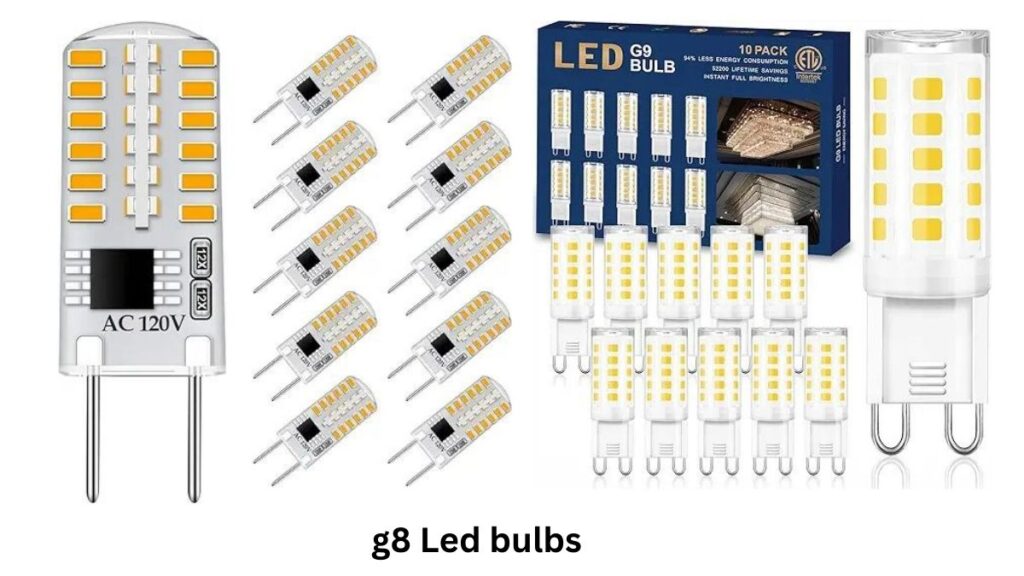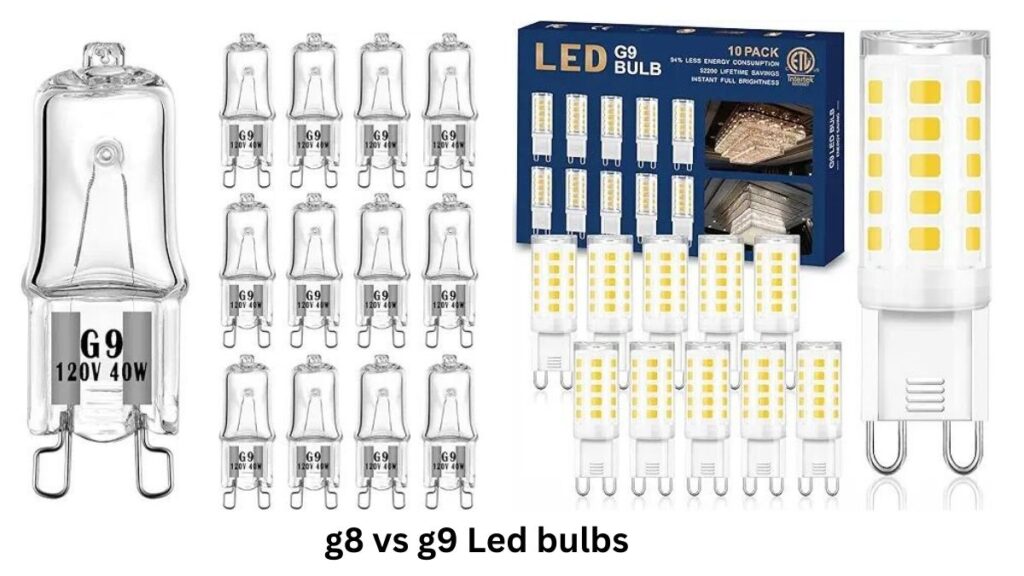Best and affordable g8 Halogen light bulbs: Check Now
Choosing the right light bulb for your home or office can be confusing, especially when faced with options like G8 vs G9 bulbs. Both are popular choices in under-cabinet lighting, pendant lights, and decorative fixtures, but they have distinct differences. This guide will help you understand these differences so you can make an informed decision. Whether you’re upgrading your lighting or replacing an old bulb, this article will break down everything you need to know.

What is a G8 Bulb?
The G8 bulb is a type of bi-pin bulb, meaning it has two pins that connect the bulb to the fixture. These bulbs are small, usually around 8mm between the pins, and are commonly used in under-cabinet lighting, desk lamps, and some pendant lights.
- Size: G8 bulbs are compact, making them ideal for smaller fixtures where space is limited.
- Brightness: They offer moderate brightness, making them perfect for task lighting.
- Energy Efficiency: G8 bulbs come in halogen, LED, and xenon versions, with LEDs being the most energy-efficient.
- Lifespan: LED G8 bulbs have a longer lifespan compared to halogen or xenon versions, often lasting up to 25,000 hours.
- Heat Output: Halogen G8 bulbs can get quite hot, whereas LED versions stay cool to the touch.
What is a G9 Bulb?
Like the G8, the G9 bulb is also a bi-pin bulb but with a slightly larger pin distance, typically 9mm apart. G9 bulbs are often used in chandeliers, wall sconces, and other decorative lighting.
- Size: G9 bulbs are slightly larger than G8 bulbs, but still compact enough for most fixtures.
- Brightness: G9 bulbs generally provide more brightness, making them suitable for both ambient and task lighting.
- Energy Efficiency: G9 bulbs are available in halogen, LED, and xenon versions, with LED options being the most energy-efficient.
- Lifespan: LED G9 bulbs also have a long lifespan, similar to G8 LEDs, often reaching up to 30,000 hours.
- Heat Output: Halogen G9 bulbs can get hot, while LED versions remain cool.
G8 vs G9: Key Differences
Understanding the key differences between G8 and G9 bulbs is crucial in selecting the right one for your needs. Let’s dive into the main factors that set them apart.
- Pin Distance: The most obvious difference is the pin distance. G8 bulbs have an 8mm gap between the pins, while G9 bulbs have a 9mm gap. This difference in pin spacing means they are not interchangeable in fixtures.
- Brightness: G9 bulbs generally produce more lumens (brightness) than G8 bulbs. This makes G9 better suited for areas where you need more light, like living rooms or kitchens.
- Application: G8 bulbs are commonly used in under-cabinet lighting and smaller fixtures, while G9 bulbs are often found in chandeliers, wall sconces, and larger decorative fixtures.
- Energy Use: Both G8 and G9 bulbs are available in energy-efficient LED versions. However, G9 bulbs usually consume more power due to their higher brightness levels.
- Lifespan: Both bulb types offer long lifespans, especially in LED form. However, G9 LED bulbs often last slightly longer than G8 LEDs.

When to Choose a G8 Bulb
G8 bulbs are an excellent choice for specific scenarios where their unique characteristics shine. Here’s when you should opt for a G8 bulb:
- Under-Cabinet Lighting: If you’re installing or replacing lights under your kitchen cabinets, G8 bulbs are ideal due to their compact size and adequate brightness.
- Task Lighting: G8 bulbs are perfect for desk lamps or reading lights where you need focused, moderate brightness.
- Energy Efficiency: If you’re looking to save on energy bills, opt for LED G8 bulbs. They consume less power while providing sufficient light.
- Heat Sensitivity: In areas where heat could be an issue, like near delicate materials or in small spaces, LED G8 bulbs are better because they stay cool.
When to Choose a G9 Bulb
G9 bulbs are better suited for different applications where more light is needed, and space isn’t as much of a constraint. Here’s when a G9 bulb is the right choice:
- Chandeliers: G9 bulbs are often used in chandeliers because of their higher brightness and ability to fill a room with light.
- Wall Sconces: For decorative wall lighting, G9 bulbs provide the right amount of brightness and are available in various color temperatures to match your decor.
- Ambient Lighting: If you need to light up a larger area, like a living room or dining area, G9 bulbs are more suitable due to their higher lumen output.
- Longer Lifespan: If you’re looking for a bulb that lasts longer, G9 LED bulbs can be a better choice, often lasting up to 30,000 hours.
LED vs Halogen vs Xenon: Which is Better?
Both G8 and G9 bulbs are available in different technologies—LED, halogen, and xenon. Each has its pros and cons, so let’s take a look at how they compare.
- LED: LED: LED bulbs are the most energy-efficient and have the longest lifespan. They also stay cool to the touch, making them safer and more suitable for enclosed fixtures. However, they are usually more expensive upfront.
- Halogen: Halogen bulbs are less expensive and offer a warm light that many people find appealing. However, they consume more energy and have a shorter lifespan compared to LEDs.
- Xenon: Xenon bulbs are similar to halogen but are slightly more efficient and have a longer lifespan. They produce a bright, white light but still generate a lot of heat.

Installation Tips
Installing G8 or G9 bulbs is usually straightforward, but there are a few things to keep in mind:
1. Check Compatibility: Always ensure that the bulb you choose is compatible with your fixture. G8 and G9 bulbs are not interchangeable due to their different pin distances.
2. Turn Off Power: Before replacing any bulb, make sure the power to the fixture is turned off to avoid any electrical hazards.
3. Handle with Care: For halogen and xenon bulbs, avoid touching the glass with your bare hands as oils from your skin can shorten the bulb’s lifespan. Use a cloth or gloves when handling them.
4. Fit Securely: Ensure that the bulb is securely fitted into the socket. A loose bulb can cause flickering or poor performance.
Energy Savings with LED Bulbs
Switching to LED G8 or G9 bulbs can result in significant energy savings over time. Here’s why:
- Lower Energy Consumption: LED bulbs use a fraction of the energy that halogen bulbs do, often reducing energy use by up to 80%.
- Longer Lifespan: With lifespans of up to 30,000 hours, LED bulbs outlast halogen and xenon bulbs, meaning you’ll replace them less frequently.
- Reduced Heat Output: LED bulbs emit less heat, which can lower cooling costs in your home, especially during summer.
Conclusion
Choosing between G8 and G9 bulbs comes down to your specific lighting needs. G8 bulbs are compact, energy-efficient, and ideal for under-cabinet or task lighting. On the other hand, G9 bulbs offer higher brightness, making them perfect for chandeliers, wall sconces, and ambient lighting.
Both bulb types are available in LED, halogen, and xenon variants, each with its own set of advantages. LEDs are the most energy-efficient and long-lasting, while halogen and xenon bulbs offer different color temperatures and brightness levels.
By understanding the key differences and knowing what to look for, you can choose the right bulb to enhance your space. Whether you’re looking for focused task lighting or bright ambient light, there’s a G8 or G9 bulb that’s just right for you.
Get g9 Baoming bulb dimmable 4 w: Check here
Related articles:
Hi, I’m Malik Suhail—an SEO expert, web designer, and passionate blogger with 2 years of experience. I specialize in crafting content that is not only informative but also tailored to meet the needs of my readers.
I write about diverse topics, always striving to simplify complex ideas and provide valuable insights that resonate with my audience. Whether it’s about SEO strategies, web design trends, or blogging tips, I am committed to delivering well-researched, practical, and easy-to-understand information.
My mission is to help readers navigate the digital world with confidence and clarity. I believe in adding value through authentic content that inspires action and delivers results.


